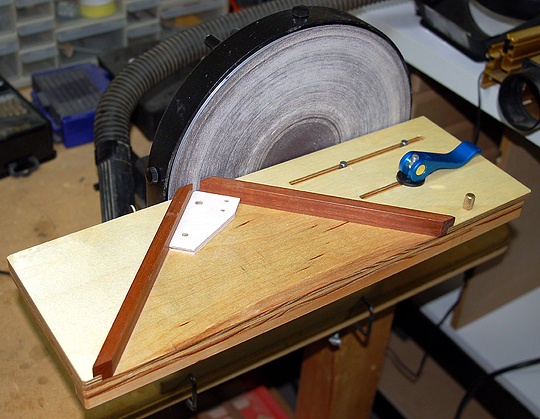Make
the Mighty Disk Sander Bevel Master
 I have decided I like bevels a lot. For many, many years my default
practice was to round over edges, ends and corners. It was just the
right thing to do in all circumstances. Sometimes the round was very
slight because I actually needed a sharp corner but wanted to remove the
wood
fuzz. Other times there is a large round-over so that when I trip over
something on the floor and quickly react to break my fall into the coffee
table with my face it hurts less. I have decided I like bevels a lot. For many, many years my default
practice was to round over edges, ends and corners. It was just the
right thing to do in all circumstances. Sometimes the round was very
slight because I actually needed a sharp corner but wanted to remove the
wood
fuzz. Other times there is a large round-over so that when I trip over
something on the floor and quickly react to break my fall into the coffee
table with my face it hurts less.
Years from now when intellectual art enthusiasts are discussing my
master works they will have a name for that era of my life. They will call it
"Paul's Age of Environment Softening to Continue Survival". Of course the
discussions will be heated and possibly lethal.
I can't predict what conclusions
our descendents
will draw but obviously they will center around the profound impact my
creations had on artist model-builders, the very significant
collateral influence on art of all genres as well as the healing of deep wounds
to
the souls of those who have lived tortured lives of hardship.
The knowledge of the beautiful light my work will shine unto this, our world, of course, humbles me.
I think I might cry.
I am now living what likely be known to the future enlightened as the "Age of
Bevels". While I have beveled corners sporadically through the years
it become a way of life sometime in 2009 or 2010.
Store those important dates away because they will be the source of many
arguments in years to come.
What these people won't know is one of my deepest, most embarrassing
secrets; using hand-tools I could not produce a consistent, matching set of bevels on a a flat
board in less than a handful of attempts. My supreme greatness has
limits. No, really.
Again, that's a secret so please keep it to yourself. We
want future society to focus on the supreme greatness part, not the
embarrassingly inept part.
|
![]()